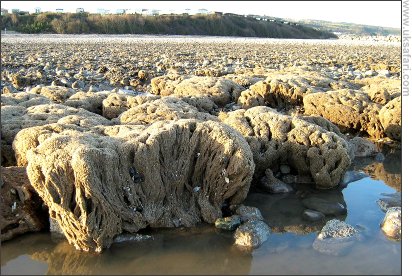
|

|
|
 Sent
to you Sent
to you
by e-mail
|
|
Simply
enter your details and hit the send button
more
info |
|


Click Here

Links
Advertise
Terms of Use
Contributors
About Us
Contact Us
|
 |
Go back
 | Bookmark
| Bookmark
 | Print Page
| Print Page  | E-Mail Us
| E-Mail Us 
Unseen
for 60 Years
____________________________________________________
Posted: 14th March 2008

Photo: CCW |
Most people in the UK have never seen one. In Britain, they live on the south and west coasts with some being found on the south east and east coasts. They've been seen as far north as the Outer Hebrides. They've even been seen on the south, west and north coasts of Ireland. But for over 60 years nobody has seen one in north Wales. Now they're back, and in the past two years they've created an amazing lunar-like landscape over 350 metres long.
The amazing structures you see above are created by Honeycomb worms (Sabellaria alveolata).
They build tubes by gluing together sand grains, gravel or shell pieces, and arranging
them like honeycomb in a bee hive.
Although quite brittle, the reefs provide some stability for a rich mix of other species including anemones, barnacles, limpets, winkles, whelks, mussels and crabs. They are also good nursery areas for fish.
 The worms
themselves are between 3cm and 4cm in length. They emerge at high tide to
feed, and at low tide they shut themselves inside their tubes, with tentacles
adapted to form a plug-like cap. The worms
themselves are between 3cm and 4cm in length. They emerge at high tide to
feed, and at low tide they shut themselves inside their tubes, with tentacles
adapted to form a plug-like cap. |
This rare habitat on the beach in Llanddulas, between Old Colwyn and
Abergele was discovered by Phil Capper, senior fisheries officer, and Vickie Hickin, biodiversity officer, for the Northwestern and North Wales Seafisheries committee.
The Countryside Council for Wales' Intertidal Team Leader, Gabe Wyn said:
"Many areas of honeycomb reef have been lost from our shores, possibly due to pollution, coastal engineering work or even bait digging. But the reef worm’s return to Llanddulas means that the conditions here must be just right for it – this is an encouraging sign about the health of the environment along this part of the Welsh coast."
Related Links:
UK Safari Marine Wildlife Section
UK Safari News
|
 |

Nature Shop

Dip Net

Palm Microscope

10X Hand Lens

Rocky Shore Trail

Seaweeds

Saltmarsh Plants

Sand Dune Plants

Shore Fishes
More Nature Watching Supplies Here >
|